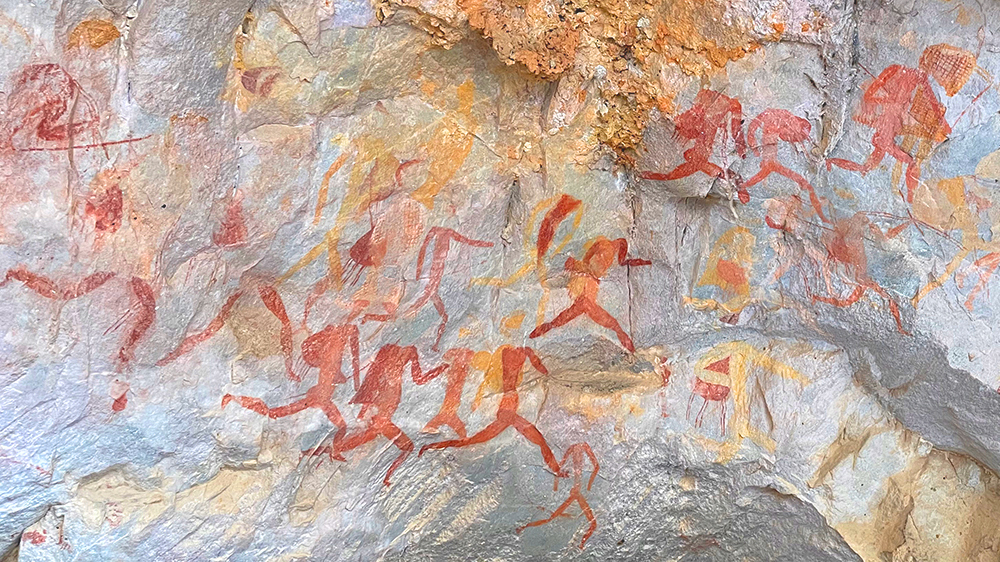Welcome to DU!
The truly grassroots left-of-center political community where regular people, not algorithms, drive the discussions and set the standards.
Join the community:
Create a free account
Support DU (and get rid of ads!):
Become a Star Member
Latest Breaking News
Editorials & Other Articles
General Discussion
The DU Lounge
All Forums
Issue Forums
Culture Forums
Alliance Forums
Region Forums
Support Forums
Help & Search
Anthropology
Related: About this forumResearcher: The people who painted these rock paintings were neither primitive nor naked

Vibeke Viestad believes that the San peoples' rock paintings were used in other contexts than previously assumed. This image shows a rock painting created by San people in the Groot Winterhoek Mountains in South Africa. (Photo: Vibeke Viestad)
Researcher: The people who painted these rock paintings were neither primitive nor naked
In a new exhibition, archaeologist Vibeke Viestad shows how we can use San people's dress and dress practices to interpret their world-renowned rock art in new ways.
Christine Gulbrandsen
COMMUNICATIONS ADVISER
Presented by:
UNIVERSITY OF OSLO
Thursday 30. November 2023 - 04:30
Thursday 30. November 2023 - 04:30
Del på Facebook Del på Twitter Del på e-post
For thousands of years, the San people painted fantastic and complex rock paintings that can be found scattered across southern Africa. But despite their early and advanced visual communication, the historical hunter-gatherer population has often been described as primitive Stone Age people.
“The San people were neither primitive nor naked. They used clothes, headdresses, bags, shoes, jewellery, tattoos, colours, and fragrance to create and maintain important social relationships between humans, between humans and animals, and between humans and other living beings,” Vibeke Viestad says. She is a researcher at the Department of Archaeology, Conservation and History at the University of Oslo.
Viestad explains that dressing the body helped create harmonious relationships that were important for living in a world that consisted of many different types of social beings.
. . .
Through ethnographic artifacts, photographs, reproductions of rock art, and information texts, she explains how dress and personal ornamentation have been used intentionally, and that they have had different significance in different phases of San people’s lives.
It is here that the connection to rock art becomes evident: The knowledge of dress and dress practices can contribute to understanding parts of the rock art and its symbolism in new ways, according to Viestad.
The traditional interpretation of rock art is that it shows trance dance as a ritual practice, specifically the shaman's role and ability to move between different worlds during a trance.
“By emphasising what clothes, bags, and decoration of the body have meant in different situations, we can understand the symbolism and significance of rock art in other ways. It's likely that the art was created and used in many different contexts, not just to convey the shaman's perspective and experiences,” Viestad says.
More:
https://partner.sciencenorway.no/archaeology-society-and-culture-university-of-oslo/researcher-the-people-who-painted-these-rock-paintings-were-neither-primitive-nor-naked/2281546
InfoView thread info, including edit history
TrashPut this thread in your Trash Can (My DU » Trash Can)
BookmarkAdd this thread to your Bookmarks (My DU » Bookmarks)
2 replies, 1340 views
ShareGet links to this post and/or share on social media
AlertAlert this post for a rule violation
PowersThere are no powers you can use on this post
EditCannot edit other people's posts
ReplyReply to this post
EditCannot edit other people's posts
Rec (21)
ReplyReply to this post
2 replies
 = new reply since forum marked as read
Highlight:
NoneDon't highlight anything
5 newestHighlight 5 most recent replies
= new reply since forum marked as read
Highlight:
NoneDon't highlight anything
5 newestHighlight 5 most recent replies
Researcher: The people who painted these rock paintings were neither primitive nor naked (Original Post)
Judi Lynn
Dec 2023
OP
cksmithy
(249 posts)1. Thank you
for all the anthropology posts. I used to subscribe to a few paper magazines about archaeology and anthropology, but too much paper to recycle and no one in my family shares my interest. I always read your posts and their links. I have always been fascinated about our ancient history and really am so glad that you share your articles on DU. Thank you.
Judi Lynn
(162,374 posts)2. Thank you for your comments. It appears the information is coming more frequently than ever, currently.
It's tremendous there are so many people who've chosen such interesting careers for their life's work, isn't it?
Looking forward to everything we're likely to discover simply through reading!
Thank you. ![]()